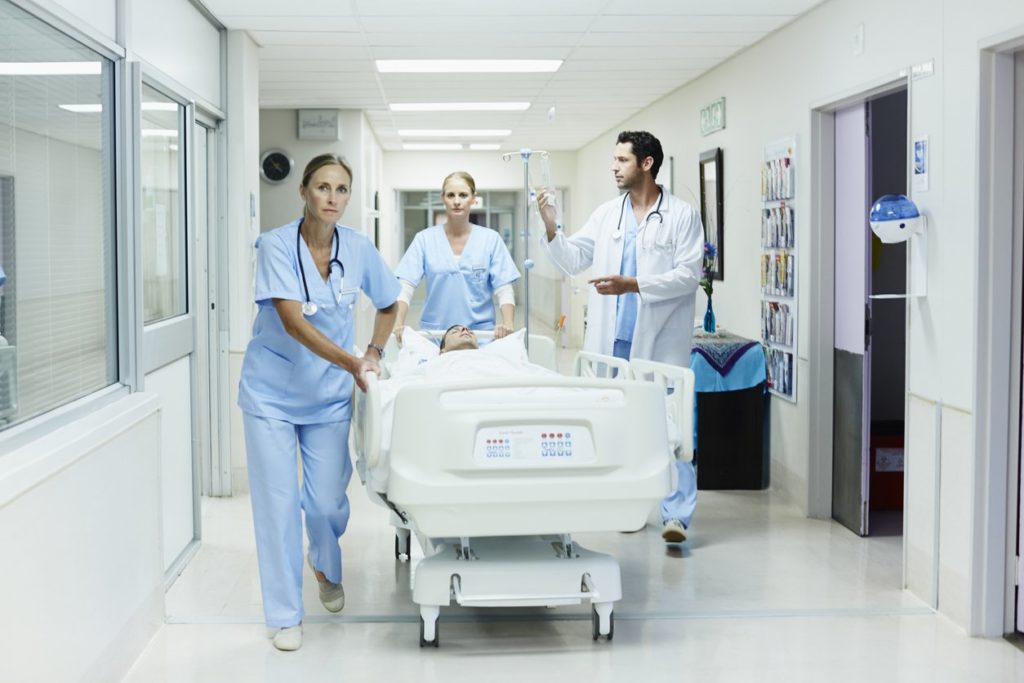Transporting patients for any reason, especially the critically ill, is a risky prospect.
Yet there are a number of reasons why a hospital may need to move a patient. Imaging is just one of those, with patients being moved to different parts of the hospital or even off premises where needed imaging equipment isn’t available.
For any clinic, managing or mitigating that risk is vital. Not only is it important for the care of the patient, but because hospitals increasingly are held responsible for any consequences of those risks.
Where CMS used to cover incidents such as infections in patients, they are often refusing to, putting the liability on the hospital. This makes limiting patient transportation and its inherent risks a priority.
The risks associated with patient transport
Typically, when a patient needs to move from their room in a hospital to receive treatments, tests or imaging elsewhere, they are not permitted to walk to those places themselves. Patient transport involves a healthcare worker taking them, usually via wheelchair or stretcher.
Transporting a patient requires knowledge, skill, good equipment and communication between patient and healthcare workers. Any of those things can break down and lead to injuries, ranging from minor scrapes to a traumatic brain injury or death, particularly as a result of a fall.
There are tens of millions of hospital admissions in the United States each year. Each of those represents a possible opportunity for a patient transport accident, even if each person is only moved once.
The prevalence of adverse events during patient transport is relatively high. Incidents happen often, although it is estimated that a large proportion of those go unreported. In one study, 45.8% of patient transports were associated with an adverse event, from minor to major. In another study, 67.9% of patient transports observed were associated with an “Unexpected Event.” These are some significant numbers – risk during patient transportation is a significant issue.
A study looking at the risks of patient transport for the critically ill highlighted a host of other risks besides transport accident. These include:
- Potential for infectious exposure
- Ventilator-acquired pneumonia
- Hypoxemia
- Pulmonary complications
- Tachycardia
- Cardiac arrest
- Arrhythmia
- Equipment dislodgement
- Interruption of therapy or care.
Particularly with critically ill patients, the risks of transporting them often outweigh the benefits. This creates a dilemma for clinicians, especially when imaging or testing is needed to help them form a thorough treatment plan.
Transporting someone who is critically ill can present more challenges, such as needing to transport therapy equipment with them and often requiring more healthcare workers for the process. Not only is it risky, but it is labor-intensive.
The risk of infection being spread via patient transportation is very well-known and very high. It has been noted repeatedly in hospitals where patients are moved between wards for non-clinical reasons, such as lack of space. Transfers hobble a hospital’s ability to contain infections and put both the transported patient and others whom they come directly or indirectly into contact with at risk.
Another review highlights that: “As the transfer of sick patient may induce various physiological alterations which may adversely affect the prognosis of the patient, it should be initiated systematically and according to the evidence-based guidelines.”
Increasingly, the Centers for Medicare and Medicaid are holding hospitals liable for any consequences as a result of patient transport. Given that hospitals are measured in many ways now, including patient outcomes, most are vitally aware of the risks involved with patient transport and have policies to mitigate them.

Limiting patient transportation
It makes sense to limit patient transportation to only when it is absolutely necessary. Fortunately, with improvements in technology today, many tests, therapies and imaging requirements can now be carried out from the patient bedside.
Point of Care imaging, where imaging needs can be carried out at or very near to the point of care is one such solution to mitigate risk. Point of care minimizes the risk of infection, or the spread of current infection, as well as the risk of any transport accidents.
Vulnerable patients can be susceptible to bed sores, cuts and grazes during transport. These seemingly minor issues can result in months of treatment for those most at-risk. By minimizing movement, these negative impacts are also minimized.
Reduced patient stays and improved overall experience
With minimized risk of illness, infection spread, or injury during transport, the total hospital stays for patients can also be reduced. The patient has better outcomes and the hospital improves patient throughput.
From the patient perspective, the overall experience can be improved by using Point of Care imaging. They get to stay in the relative comfort and security of their own room while the imaging equipment comes to them. For many ill or injured patients, transport of any kind brings huge discomfort – this is one way that hospitals can improve their experience.
Improved clinical research and efficient use of resources
When you consider that the extent of illness or injury may prohibit a patient from being transported to receive imaging, portable equipment represents a game-changer. Bringing the imaging to the patient in these cases allows for clinical research that may be transformative, and that may otherwise have not been conducted.
Hospitals should also consider that Point of Care imaging helps them to make more efficient use of their healthcare workers. Transportation of injured or ill patients can involve an entire team of people, whereas portable imaging only requires one employee: a Nuclear Medicine Technologist (NMT).

Portability in the OR
Portable imaging is also making an impact in the OR. The Digirad Ergo Imaging System was highlighted in the Journal of Pediatric Surgery for the improvements it makes to the OR environment.
Specifically, a major risk of any OR is the time spent by the patient under anesthesia. The longer the patient is under, the more risky it becomes. When surgeries require imaging to go ahead, in many cases (such as lymph node biopsies in children), it is necessary to sedate the patient, undergo mapping in a nuclear imaging suite, then transport them to the OR for surgery. This extra step in the process adds to transport risk and to the risk of time under anesthesia.
Point of Care imaging means that those images can be acquired in the OR, the area prepared, then the surgery can begin without delay. This also reduces downtime in the OR. When the procedure and the surgery are done in one environment, it’s safer for the patient, spares them additional time under anesthesia, and alleviates the need for transport.
Final thoughts
Patient transport is inherently risky for hospitals and the patients they care for. Accidents, infection spread and deteriorated patient states as a result of transport are relatively common and can severely set back recovery times.
It makes sense to limit patient transport where possible, and implement Point of Care therapies, tests and diagnostics. Portable imaging is one way to reduce infection spread and achieve better outcomes for patients and hospitals.
Most critical imaging needs can be catered for at the patient bedside. For hospitals, this can be an investment with great returns.




